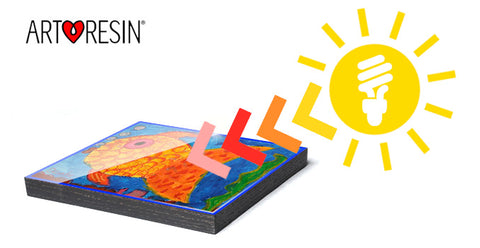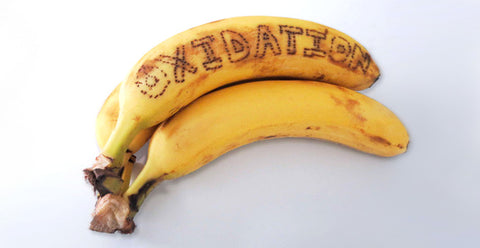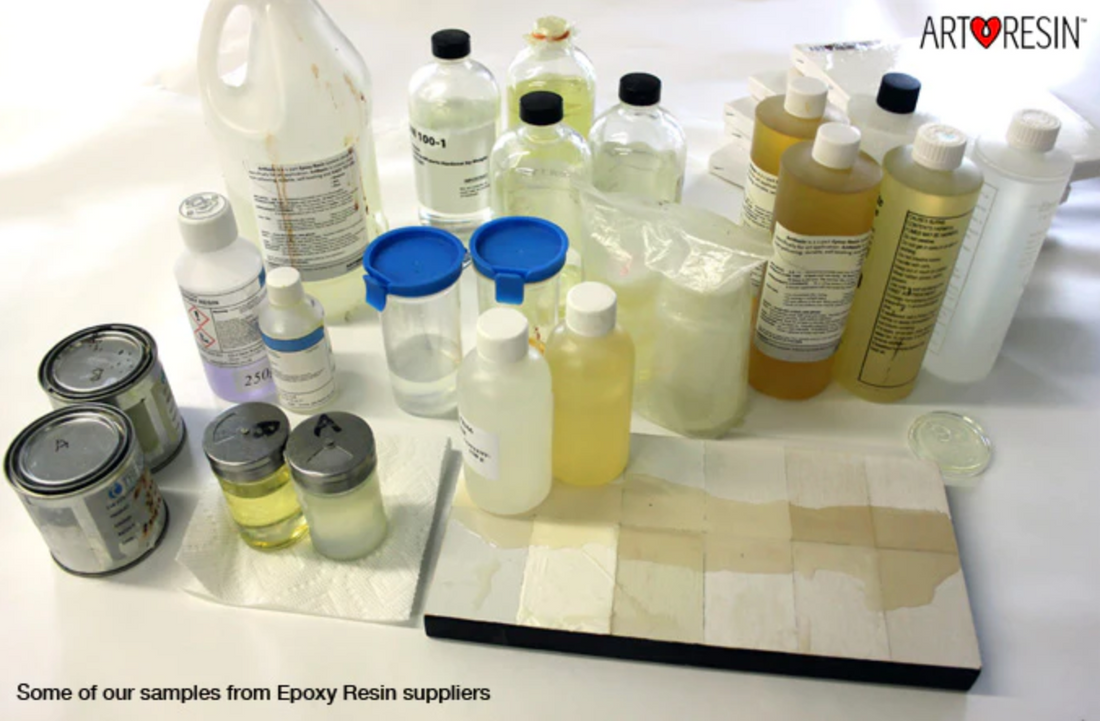Click here to view third party yellowing test data featuring various popular epoxy resin brands.
Chances are if you've landed on this page, you've had a beautiful piece of art turn yellow after using a resin product that's not specifically formulated for use over creative projects. Total bummer. Here's why it happened and how to avoid it for next time.

The Effects of UV Light on Epoxy Resin
If you aren't using ArtResin epoxy resin then your work is in real danger of discoloration from the natural environment. UV light is to blame for changes to cured epoxy resin over time. When UV light hits the resin—either directly or indirectly—it degrades the polymers. Although this degradation from UV light is a natural process (UV light is typically always harmful to everything on earth over time), it causes observable, undesirable, aesthetically displeasing characteristics, such as:
- gloss loss
- de-lamination
- cracking
- chalking
- YELLOWING
A UV stabilizing agent can be added to epoxy resin formulas to mitigate these effects. UV stabilizers are very effective at preventing gloss loss, de-lamination, cracking and chalking, but they merely delay discoloration. In other words, yellowing is still inevitable with a UV stabilizer alone. Yellowing first presents as a light tone all over, then progressively darkens until it reaches a dark brownish-yellow hue. Yellowing will be accelerated with exposure to UV light. A resined piece that is placed outside will generally reach its dark brown-yellow color within 24 hours. Artwork that is kept indoors will begin to discolor generally within 6 months to a year if it was coated in a resin product that contained only a UV stabilizer. If the resin did not contain a UV stabilizer at all, it will reach a dark yellowing much faster, within approximately 2-3 months. Discoloration has also been demonstrated in pieces that have been kept in complete darkness.
* It should be noted that yellowing can occur as a result of an undesirable interaction between Titanium Dioxide (found in white pigments) and ANY brand of epoxy resin.
All Epoxy Resins Are NOT Created Equal
There are many, many uses for epoxy resin, only one of which is as a clear coating for artwork and other creative applications. Many epoxy resin products on the market are sold as adhesives and most are intended for industrial use, not home/studio use. Many resins are made for the marine industry because epoxy is a durable, waterproof product. In most cases, epoxy resins are not formulated specifically to maintain clarity over the long term, as artists require. Further, most resins are considered a hazardous material due to their chemical composition; they are intended for use in industrial settings where hazmat suiting is readily available and required. Any resin that quickly yellows is not adequately formulated for use over artwork. Any artist thinking of using resin over their artwork should certainly choose a product that has been formulated for creative purposes, namely that it is both UV and HALS stabilized, and deemed non-toxic when used as directed and safe for home use in a well ventilated area. See our SDS for more information.

How To Protect Your Artwork Against Yellowing
UV stabilizers are not enough to prevent yellowing in epoxy resin. If you are coating pieces of art—or anything creative, special and important—then you need a product that contains an additive called 'HALS', in addition to a UV stabilizer. HALS stands for Hindered Amine Light Stabilizer. It's job in the formula is solely to address yellowing. How does it do this? HALS scavenges radicals that are produced with UV light exposure, thus diminishing the degradation cycle that causes yellowing. It's protection abilities has been demonstrated time and again since it came into existence in the 1960s. A UV stabilizer is still necessary to protect against the other problems that result from UV light degradation, however HALS is the number one agent that works to address yellowing.
...So what epoxy resin product is specially formulated for creative projects? that contains both an HALS and a UV stabilizer? that has been deemed non-toxic when used as directed and safe for home use? that is an easy 1:1 mixing ratio, and that produces a gorgeous, glossy finish? It's ArtResin.
Why Epoxy Hardener Sometimes Changes Color in the Bottle
If you've found that your epoxy hardener has discolored in the bottle, this is caused by oxidation, not UV light. The hardener will yellow in its liquid state more quickly once the bottle has been opened because it has been exposed directly to oxygen, and this will always be more noticeable in larger containers (just as how the ocean looks blue but a cup of water looks clear). It can still yellow very slightly if unopened due to the fact that the HDPE plastic bottles it comes packaged in does breathe a little, allowing oxidation to occur. For this reason, epoxy resins will always have a shelf life. Once a product has begun to yellow in the bottle, it can still be used (i.e. it will still cure properly). It will always appear less yellow on a piece due to the fact it must be mixed with an equal part of resin thereby diluting it, and the product will be spread out in a thin layer making any observable discoloration much less observable.

Do you want to learn more about epoxy resin and yellowing? Read our guides below:
- Why Does My Resin Look Yellow?
- What Is Hals & UV Stabilization?
- What Can You Do With Yellowed Hardener?
- ArtResin's Protection Against Yellowing


